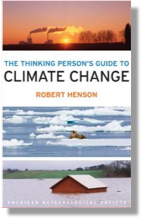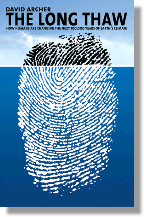|
* Apple users running MacOSX 10.4 or later must
install Microsoft's Silverlight software in order to view the streaming videos marked with *.
Once installed, restart your browser before viewing.
Silverlight 4.0 intel (14MB) |
Silverlight 1.0 ppc (5MB)

WATCH
AND
LISTEN |
under 10 minutes |
Global Warming: It's All About Carbon
Robert Krulwich and Odd Todd, Wild Chronicles, NPR and PBS
This 5-part cartoon series is amusing and informative. Robert Krulwich is a
science correspondent for NPR and co-host of the program Radiolab; Odd Todd
is the cartoonist. This page also links to NPR's Climate Connections website.
(4 minutes)
Trend and Variation
teddytv and Christoffer Haga
A clever explanation of the difference between trend and variation, climate
and weather, involving a man walking a dog.
(1 minute)
Why Greenhouse Gases Make the Planet Warmer
low-res stream |
med-res stream |
QuickTime movie
Scott Denning, Department of Atmospheric Science,
Colorado State University
A stripped-down explanation of the structure of
greenhouse gas molecules like CO2 and how they trap heat in our
atmosphere.
(7 minutes, September 2009) |
| |
longer |
For longer, more thorough, older-but-still-accurate videos by climate
scientists David Randall and Scott Denning, see our
archive.
Climate Change: The Basic Science is Simple
Scott Denning, Colorado State University
In this first third of a three-part talk (Climate Change: Simple, Serious,
Solvable), Changing Climates @ Colorado State climate scientist Scott Denning
lays out the very basic, long-understood reasons the planet is warming from
our use of carbon-based fuels. Crystal clear, common-sense, and entertaining.
(17 minutes, 2017)
|
| READ |
books |
 The Thinking Person's Guide to Climate Change
The Thinking Person's Guide to Climate Change
Robert Henson. American Meteorological Society (distributed by
the University of Chicago Press), 2014, 416pp.
Formerly The Rough Guide to Climate Change, of which this is essentially the
4th edition, this book is an excellent, highly readable overview, with major
sections on the basics, the
symptoms, the science, debates and solutions, "what you can do," and
resources. A staff writer at the National Center for Atmospheric Research,
NCAR, Henson is a gifted explainer of complicated subjects. He addresses
common questions and confusions, offers vivid examples relevant to everyday
life, includes many photographs, graphs, and other helpful illustrations,
and makes clear where and why scientists are more or less confident about
their data and predictions.
 The Long Thaw: How Humans are Changing the Next 100,000 Years of Earth's
Climate
The Long Thaw: How Humans are Changing the Next 100,000 Years of Earth's
Climate
David Archer. Princeton University Press, 2009, 178 pp.
A lucid account of the current situation and of past and future climates.
Professor of geophysical sciences at the University of Chicago and frequent
contributor to RealClimate.org, Archer talks about such things as ocean
acidification and carbon-cycle feedbacks, but he focuses especially on
explaining how the time scales of natural climate change compare to those of
the human-caused changes now underway. "Global warming," he says, "could be
one of humankind's longest lasting legacies"‒lasting "longer than nuclear
waste, far longer than the age of human civilization so far."
|
| |
articles & essays |
FOCUS on the Climate/Human Past
What has happened in the past to Earth's climate, and how, in more recent
millenia, have those changes affected human beings? See this page for sources
on both paleoclimate science and some of the connections with human history
that historians, geographers, climatologists, and anthropologists are
exploring.
Trees Could Change the Climate More than Scientists Thought
Gabriel Popkin and Quanta, The Atlantic, October 2018
Though this science is a good deal older than this article suggests, here is
a good explanation of how forests apparently affect weather and climate, not
just the reverse.
To Understand What We're Doing to the Planet, You Need to Understand this Gigantic Measurement
Chris Mooney, Washington Post, July 2015
Meet the gigaton‒the unit you need for understanding the size of ice
melting, sea level rising, and carbon added to the air. It is a mind-bending
number, but Mooney's explanation and analogies are helpful. He quotes one
major research institution, for instance: "The amount of carbon we are putting
into the atmosphere each year is equal to 20 times the weight of the current
world population."
Five Things to Know about Carbon Dioxide
Bob Henson, AtmosNews, NCAR/UCAR, May 2013
Written on the occasion of the first time CO2 concentrations were measured at
400 parts per million, this clear piece addresses the weight of this gas, how
it is measured and modeled, how it disperses and persists, why US emissions
have dropped, and how possible future scenarios are now being assessed.
Climate Literacy
Seven key concepts for climate literacy prepared by top-level scientists
associated with the U.S. Global Change Research Program, Climate Change
Science Program, National Oceanic and Atmospheric Administration, American
Association for the Advancement of Science, National Science Foundation, and
other major agencies.
|
| |
websites |
Intergovernmental Panel on Climate Change (IPCC) Assessment Reports
Primary source documents representing the work of thousands of scientists from
around the world, approved by the governments of over a hundred nations,
including the U.S. Non-specialists may find the summaries for policy makers
and frequently asked questions documents especially useful; the full reports
contain important technical information, charts, and graphs. The latest
reports are from 2014.
|
| TEACH |
classes |
Open Climate Change 101
David Archer, Geophysical Sciences,
University of Chicago
This free, online course by a leading climate scientist offers thirteen weeks
worth of lectures intended for interested people without a science background.
Includes quizzes and tutorials; not-for-credit; based on Archer's textbook
Global Warming: Understanding the Forecast. As of fall 2013, offered
via Coursera.
Climate and Climate Change
Thomas Ackerman, Department of Atmospheric Science,
University of Washington
This quarter-long course for non-science majors focuses on "the earth climate
as a coupled system including the interactions between atmosphere, ocean,
cryosphere, and biosphere."
|
|
resources |
Carbon on the Move
NOAA
This very simple explanation of how carbon moves around on our planet, taking
different forms, is aimed at children but will work for adults who have
forgotten what they learned long ago.
Games and Simulations-Weather, Climate, Atmosphere
A helpful collection of annotated links to (mostly free) simulations, games,
and virtual labs, maintained by UCAR's Randy Russell. Other online data
sources recommended by science teachers for classroom use are
Cryosphere Today and
Berkeley Earth. Some
are for children, but most are good even for adults.
CLEAN: The Climate Literacy and Energy Awareness Network
This extensive website is a key resource for anyone who teaches climate
science, climate change, or energy awareness to students from grade 6 through
college. It offers "Digital resources . . . reviewed by educators and
scientists, and annotated and aligned with standards and benchmarks"‒and
a lively online community of people working to increase public climate
literacy.
Windows to the Universe
This rich and popular website offers "documents, including images, movies,
animations, and data sets, that explore the Earth and Space sciences and the
historical and cultural ties between science, exploration, and the human
experience"; it has excellent materials on climate and climate change.
Designed in large part for teachers and students, it provides all its content
in both English and Spanish and at three reading levels, elementary, middle
school, and high school. Housed at the National Center for Atmospheric
Research (NCAR) until 2010, W2U now lives at the National Earth Science
Teachers Association.
|
|
|



